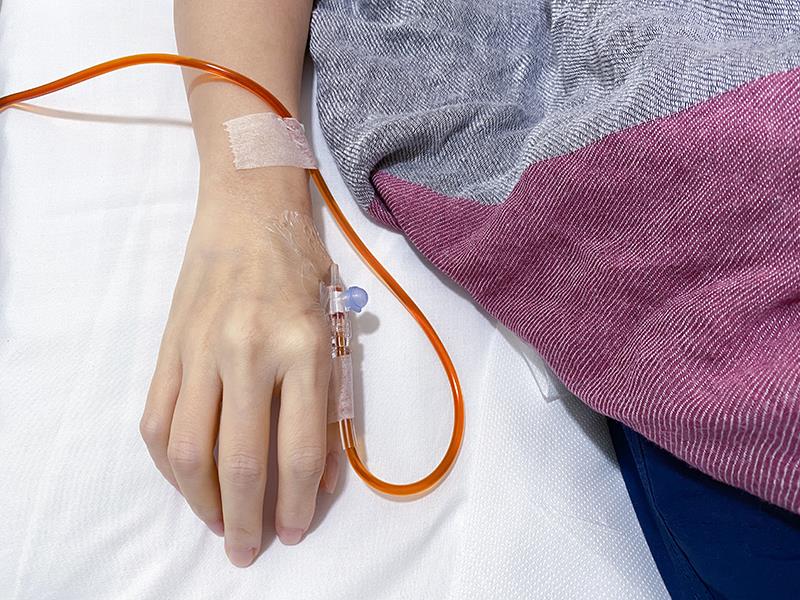IV edges out oral iron in reducing iron-related anaemia in mothers-to-be





Ferric carboxymaltose (IV iron) is no better than ferrous sulfate (oral iron) taken three times daily in reducing the prevalence of maternal anaemia near term in pregnant women with moderate or severe anaemia; however, a one-time infusion of the former over 15–20 min is more effective at reducing iron deficiency anaemia (IDA), as shown in the IVON trial presented at RCOG 2024.
Among pregnant women at 20–32 weeks’ gestational age with haemoglobin (Hb) levels <10 g/dL at baseline, the prevalence of anaemia of all severities (Hb <11 g/dL) at 36 weeks’ gestation was similar between those who received ferric carboxymaltose and those who received ferrous sulfate at a dose of 195 mg elemental iron per day (58 percent vs 61 percent; risk ratio [RR], 0.95, 95 percent confidence interval [CI], 0.85–1.06; p=0.36).
On the other hand, a single dose of ferric carboxymaltose reduced the prevalence of IDA (Hb <11 g/dL and serum ferritin <30 μg/L) to 2 percent vs 10 percent with oral iron at the same timepoint (RR, 0.22, 95 percent CI, 0.12–0.42; p<0.0001). Iron deficiency (ferritin <30 μg/L) was also less common in those treated with the former than the latter (5 percent vs 16 percent; RR, 0.27, 95 percent CI, 0.17–0.42; p<0.0001). [RCOG 2024, abstract OS-81]
There was a more pronounced increase in mean Hb from baseline to 4 weeks following treatment initiation with ferric carboxymaltose vs ferrous sulfate (p for interaction=0.0003). [Lancet Glob Health 2024;12:e1649-e1659]
“To our knowledge, this is the largest randomized controlled trial comparing the effectiveness of IV iron vs oral ferrous sulfate among pregnant women,” said Dr Ochuwa Babah, a consultant obstetrician and gynaecologist at the Lagos University Teaching Hospital, Lagos, Nigeria. “Our study found that IV iron was more effective than oral iron in increasing mean Hb at 4 weeks post-treatment and nearly eliminated iron deficiency among treated women at 36 weeks’ gestation.”
IVON was a multicentre effectiveness-implementation hybrid study that included an effectiveness trial (n=1,056) comparing two iron treatment options among pregnant women from two populous states in Nigeria. [Trials 2022;23:763] The median gestational age at enrolment was 25 weeks.
At baseline, iron deficiency was present in 39.8 percent of the randomized women. In the iron-deficient subgroup, ferric carboxymaltose was significantly more effective than ferrous sulfate in resulting in a lower proportion of women with all-cause anaemia persisting at 36 weeks’ gestation (54 percent vs 65 percent; RR, 0.83, 95 percent CI, 0.71–0.98). Iron deficiency status served as a significant treatment effect modifier (p for interaction=0.039) in light of the null effect in the non–iron-deficient subgroup (60 percent vs 59 percent; RR, 1.04, 95 percent CI, 0.91–1.18).
The incidence of preterm birth (<37 weeks’ gestation) — the other primary outcome measure — was similar between the IV and oral iron groups (14 percent vs 15 percent; RR, 0.94, 95 percent CI, 0.70–1.26; p=0.66).
Transient hypophosphataemia, a known risk associated with the use of ferric carboxymaltose, was also observed. At 4 weeks post-enrolment, the incidence of hypophosphataemia was considerably higher in the ferric carboxymaltose arm (10.6 percent vs 1 percent; p<0.001). However, the occurrence of hypophosphataemia did not differ between treatments at any other timepoint or in cord blood.
“As women in the IDA subgroup had a significant reduction in anaemia … and as ferric carboxymaltose is safe, we recommend that it should be considered in anaemic women and prioritized for women with confirmed iron deficiency,” concluded Babah and colleagues.